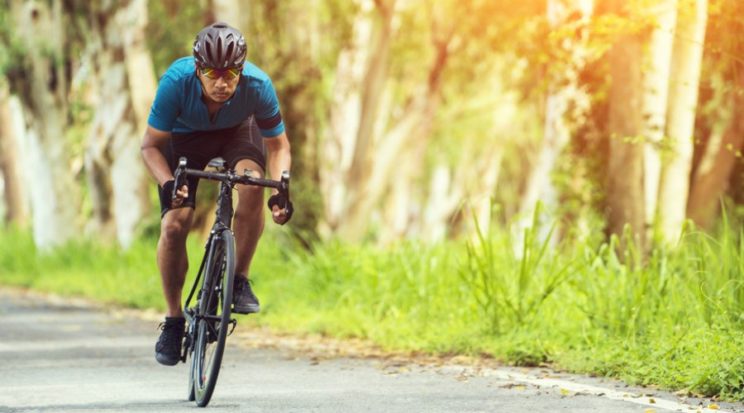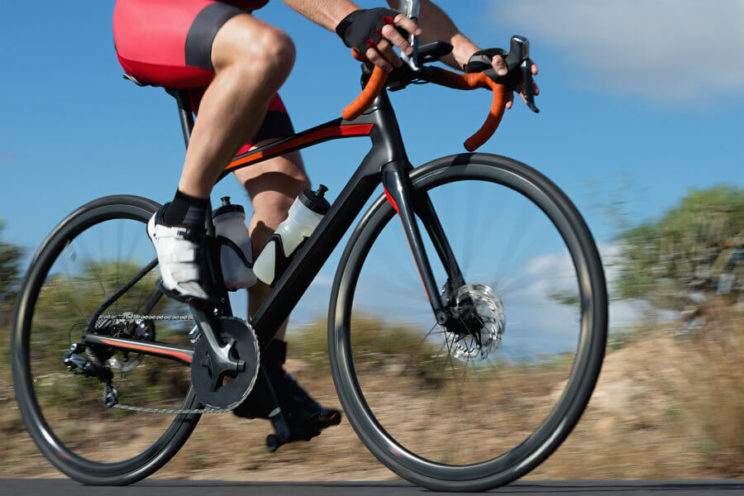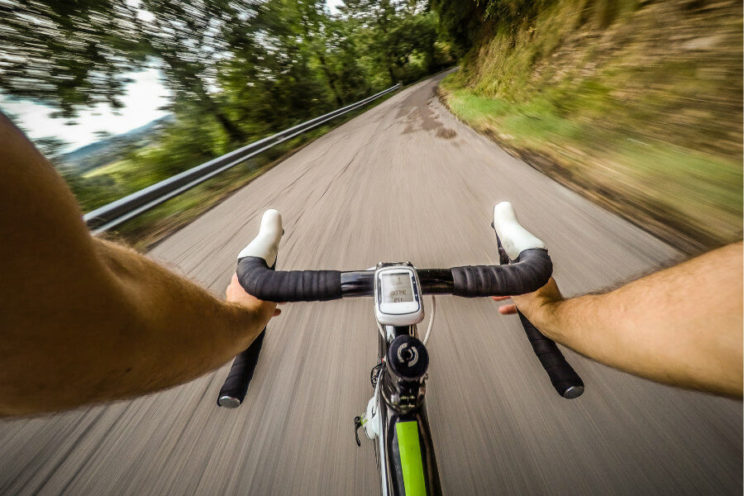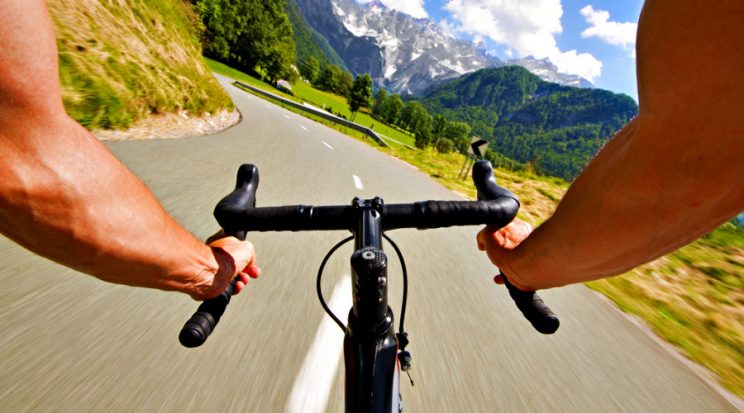If you like to climb and lower mountain ports with your road bike, but you still suffer in ascension or do not descend quickly and sure enough, you must improve not only in the physical appearance. Also in others such as pedaling cadence, posture, technique or bicycle assembly.
These improvements, in which many cyclists do not repair, and that professionals take into account very much, can assume the difference between success and failure in a long ascent or in a revidented descent. We show you below simple but useful tips to overcome mountain roads with solvency.
How to improve a mountain port on the climb

Having a light bicycle and strong legs are the first arguments that come to our heads when we think about how to improve our performance by uploading mountain ports.
Nevertheless, they are not the only ones. The development of the transmission, the cadence of pedaling, the type of training and even the way we feed and hydrate when we rolling by bicycle on mountain roads are also key.
>> See climbing bicycles for mountain ports
Control your weight
To upload a mountain port with ease and without suffering too much you must have a good relationship between weight and power, the famous watt per kilo (w/kg) that obsess professional cyclists.
And for this, the first step is to control your weight. This implies, in practice, improving your diet, opting to drink low -fat foods and eating fruit or vegetables usually. Downloading those kilos of more, always in a healthy way and to some limit, is the first step and the fastest to begin to improve the relationship between weight and power.
[IRP posts = "2041" name = "The key to lighten the weight of your bicycle is on the wheels"]
Train by series

The second aspect, the improvement of power, is achieved with training. An amateur cyclist with little experience tends to train by sensations. But organizing a session through series is a first shortcut to improve performance in a short time.
First study what parts of the climb you feel worse, from what percentage of slope your legs begin to suffer or what type of ascents are the ones that best adapt to you.
From there we will have to establish series with repetitions to improve the rhythm in long and laid increases (with slopes of between 3%and 9%, for example), or for shorter and more explosive ramps (from 10%) . Know your weak points and improve them on the ground.
At this point it is advisable to have the advice of a specialized coach, who can also guide you about exercises outside the bike (CORE, devices) to increase the force of the muscles.
[IRP Posts = "1452" Name = "Training Plan to start in triathlon"]
Find your best cadence
The pedaling power is determined by the force multiplied by the cadence. That is why it is important to address the improvement of this last aspect to increase the efficiency of each pedal.
In the middle term there is virtue, but opt for a short development if you have not yet trained enough, even if the advance is less, it will help you climb without suffering much muscle wear.
Enter (if necessary) changes in the transmission group

If your bike comes standard with developments that do not allow you to adapt the pedaling cadence to your needs, it falls short or they are very long, you will have to consider their substitution.
Many transmission groups are compatible with several development combinations, either changing or adding a single crown, the complete cassette or mounting some dishes of different development (the most climbing combinations are 50/34 or 48/33), depending on of your needs.
The improvement can be very significant in practice. But you will have to weigh before if it is worth the replacement of the pieces, because they usually have a high price.
Feed yourself and hydrate well
Controlling the physiological aspect during the port ascension itself is vital to avoid fatigue or have a bird, that is, so that you do not exhaust the energy reserves of your body.
The low level of blood glucose is the head of the appearance of cramps and birds or sudden drop in performance.
That is why it is important to keep your energy reserve full at all times, ingesting foods such as fruits, bars, gels, etc. before, during and after the port.
Do not forget to hydrate correctly, every 10 or 15 minutes, according to the majority of sports nutrition experts, regardless of whether you are thirsty or not.
How to improve the descent of a mountain port

At this point, it is necessary to clarify that a mountain road is not a competition circuit. We are used to seeing professional cyclists of the Tour de France or the return to Spain descend ports at full speed, drawing the curves from side to side.
However, in a competition the road is closed only for cyclists. The reality is that if you are going to train or make a route through mountain ports you have to share the road with motor vehicles, so the risk of suffering an accident multiplies.
The following tips have to do with a technical point of view, but before applying them, keep in mind that you are not alone on the road and that security is the most important.
[IRP Posts = "1926" Name = "What is the best posture to lower a port faster?"]
Grab the lower part of the handlebar
Once you have crowned the port, it is time to face the descent, the part that fear many cyclists for the speed and the greatest risk of falls.
The first thing to do to increase the control of the bicycle and, consequently, our safety and trust, is to roll from the lower part of the handlebar.
Do not support your hands on the handles or in the straight part of the handlebar, since they do not exert the necessary force at this point to control the direction.
Nor can you act the brake lever with force or adopt an aerodynamic posture that allows you to increase speed (up to 10% in many cases) and overcome the curves with greater fluidity.
Look in front and anticipate

Usually the drops of any mountain port are plagued by curves, many of them horseshoe with 180º.
It is important to direct your look forward and study at the same time the turns that are approaching, in order to have room and react quickly, gently braking if necessary to always stay in the fastest path. Anticipation is key to gaining safety in the descent.
How to draw the curves in the descents
Knowing how to draw the curves of a descent is crucial to get the maximum performance and finish it without mishaps. The trick is in anticipated previously and direct your bicycle looking for the vertex of the curve, the inner point that divides it into two.
To achieve this, slowly slow down and in advance to adapt the speed and avoid getting out of the traced. Once you start turning, do not touch the brake at any time, except to correct a possible diversion of the chosen line, and pass next to the vertex. Once surpassed, do not start pedaling until you do not completely leave the curve and have a straight bicycle.
Freen fair

There are many cyclists who, either out of fear or little practice in declines, abuse the use of the brake believing that they descend more safely. That is false, since the risk of making a mistake and ends up falling is much greater, although it can be paradoxical.
Only brake handlets should be operated before a closed curve or to slightly correct a diversion of the traced, and they should always be pressed progressively and softly, first the rear and then the striker.
The rest of the time will be their hands resting on the lower part of the handlebars and the body who direct the bicycle.
Lose fear and enjoy
It is perhaps the most important advice of all. The negative slope of a descent should be your ally to gain seconds to the chrono, and not to the contrary.
Mentally faces the descent of a port as an opportunity, not as a difficulty. Assume that you are going to do it well, concentrate and advance your gaze to study the descent in real time and direct the bicycle through the fastest line. It is the key to losing your fears.
In this interactive video that Eurosport published a few years ago they can be seen clearly, and taking the example of a descent from the professional cyclist Vincenzo Nibali (one of the best downspouts in the platoon), these and other tricks to better lower a mountain port With your road bike.
https://youtu.be/QJlYz45k1Hc
 Having a light bicycle and strong legs are the first arguments that come to our heads when we think about how to improve our performance by uploading mountain ports.
Nevertheless, they are not the only ones. The development of the transmission, the cadence of pedaling, the type of training and even the way we feed and hydrate when we rolling by bicycle on mountain roads are also key.
>> See climbing bicycles for mountain ports
Having a light bicycle and strong legs are the first arguments that come to our heads when we think about how to improve our performance by uploading mountain ports.
Nevertheless, they are not the only ones. The development of the transmission, the cadence of pedaling, the type of training and even the way we feed and hydrate when we rolling by bicycle on mountain roads are also key.
>> See climbing bicycles for mountain ports
 The second aspect, the improvement of power, is achieved with training. An amateur cyclist with little experience tends to train by sensations. But organizing a session through series is a first shortcut to improve performance in a short time.
First study what parts of the climb you feel worse, from what percentage of slope your legs begin to suffer or what type of ascents are the ones that best adapt to you.
From there we will have to establish series with repetitions to improve the rhythm in long and laid increases (with slopes of between 3%and 9%, for example), or for shorter and more explosive ramps (from 10%) . Know your weak points and improve them on the ground.
At this point it is advisable to have the advice of a specialized coach, who can also guide you about exercises outside the bike (CORE, devices) to increase the force of the muscles.
[IRP Posts = "1452" Name = "Training Plan to start in triathlon"]
The second aspect, the improvement of power, is achieved with training. An amateur cyclist with little experience tends to train by sensations. But organizing a session through series is a first shortcut to improve performance in a short time.
First study what parts of the climb you feel worse, from what percentage of slope your legs begin to suffer or what type of ascents are the ones that best adapt to you.
From there we will have to establish series with repetitions to improve the rhythm in long and laid increases (with slopes of between 3%and 9%, for example), or for shorter and more explosive ramps (from 10%) . Know your weak points and improve them on the ground.
At this point it is advisable to have the advice of a specialized coach, who can also guide you about exercises outside the bike (CORE, devices) to increase the force of the muscles.
[IRP Posts = "1452" Name = "Training Plan to start in triathlon"]
 If your bike comes standard with developments that do not allow you to adapt the pedaling cadence to your needs, it falls short or they are very long, you will have to consider their substitution.
Many transmission groups are compatible with several development combinations, either changing or adding a single crown, the complete cassette or mounting some dishes of different development (the most climbing combinations are 50/34 or 48/33), depending on of your needs.
The improvement can be very significant in practice. But you will have to weigh before if it is worth the replacement of the pieces, because they usually have a high price.
If your bike comes standard with developments that do not allow you to adapt the pedaling cadence to your needs, it falls short or they are very long, you will have to consider their substitution.
Many transmission groups are compatible with several development combinations, either changing or adding a single crown, the complete cassette or mounting some dishes of different development (the most climbing combinations are 50/34 or 48/33), depending on of your needs.
The improvement can be very significant in practice. But you will have to weigh before if it is worth the replacement of the pieces, because they usually have a high price.
 At this point, it is necessary to clarify that a mountain road is not a competition circuit. We are used to seeing professional cyclists of the Tour de France or the return to Spain descend ports at full speed, drawing the curves from side to side.
However, in a competition the road is closed only for cyclists. The reality is that if you are going to train or make a route through mountain ports you have to share the road with motor vehicles, so the risk of suffering an accident multiplies.
The following tips have to do with a technical point of view, but before applying them, keep in mind that you are not alone on the road and that security is the most important.
[IRP Posts = "1926" Name = "What is the best posture to lower a port faster?"]
At this point, it is necessary to clarify that a mountain road is not a competition circuit. We are used to seeing professional cyclists of the Tour de France or the return to Spain descend ports at full speed, drawing the curves from side to side.
However, in a competition the road is closed only for cyclists. The reality is that if you are going to train or make a route through mountain ports you have to share the road with motor vehicles, so the risk of suffering an accident multiplies.
The following tips have to do with a technical point of view, but before applying them, keep in mind that you are not alone on the road and that security is the most important.
[IRP Posts = "1926" Name = "What is the best posture to lower a port faster?"]
 Usually the drops of any mountain port are plagued by curves, many of them horseshoe with 180º.
It is important to direct your look forward and study at the same time the turns that are approaching, in order to have room and react quickly, gently braking if necessary to always stay in the fastest path. Anticipation is key to gaining safety in the descent.
Usually the drops of any mountain port are plagued by curves, many of them horseshoe with 180º.
It is important to direct your look forward and study at the same time the turns that are approaching, in order to have room and react quickly, gently braking if necessary to always stay in the fastest path. Anticipation is key to gaining safety in the descent.
 There are many cyclists who, either out of fear or little practice in declines, abuse the use of the brake believing that they descend more safely. That is false, since the risk of making a mistake and ends up falling is much greater, although it can be paradoxical.
Only brake handlets should be operated before a closed curve or to slightly correct a diversion of the traced, and they should always be pressed progressively and softly, first the rear and then the striker.
The rest of the time will be their hands resting on the lower part of the handlebars and the body who direct the bicycle.
There are many cyclists who, either out of fear or little practice in declines, abuse the use of the brake believing that they descend more safely. That is false, since the risk of making a mistake and ends up falling is much greater, although it can be paradoxical.
Only brake handlets should be operated before a closed curve or to slightly correct a diversion of the traced, and they should always be pressed progressively and softly, first the rear and then the striker.
The rest of the time will be their hands resting on the lower part of the handlebars and the body who direct the bicycle.












